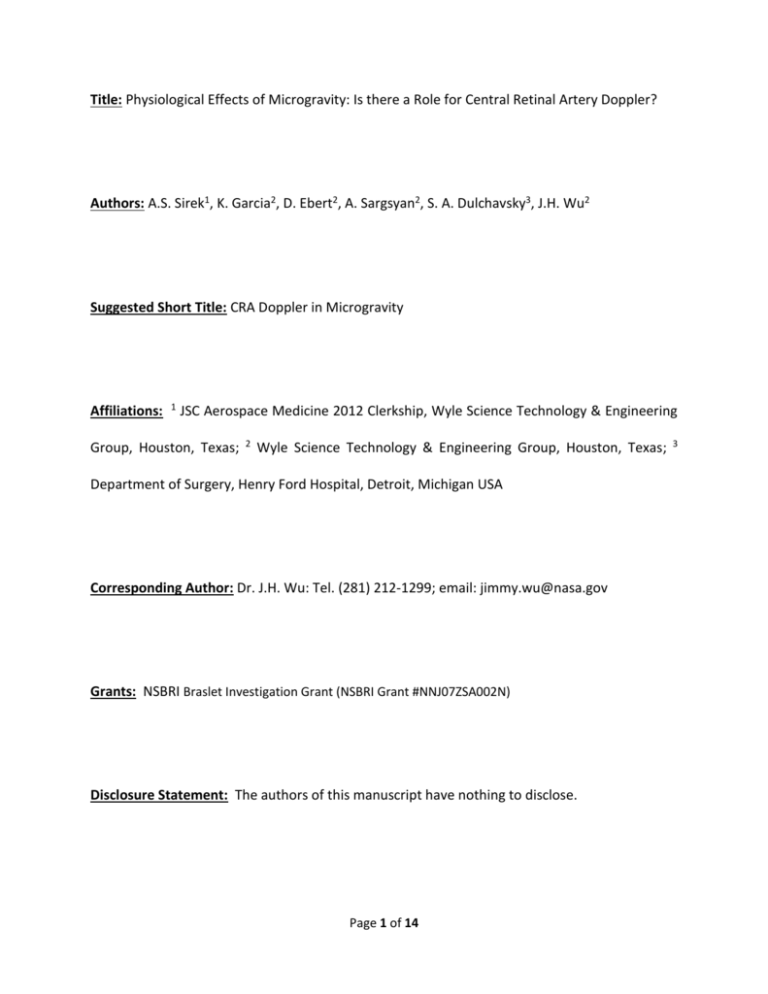Young Investigators Award Paper 2013
advertisement

Title: Physiological Effects of Microgravity: Is there a Role for Central Retinal Artery Doppler? Authors: A.S. Sirek1, K. Garcia2, D. Ebert2, A. Sargsyan2, S. A. Dulchavsky3, J.H. Wu2 Suggested Short Title: CRA Doppler in Microgravity Affiliations: 1 JSC Aerospace Medicine 2012 Clerkship, Wyle Science Technology & Engineering Group, Houston, Texas; 2 Wyle Science Technology & Engineering Group, Houston, Texas; Department of Surgery, Henry Ford Hospital, Detroit, Michigan USA Corresponding Author: Dr. J.H. Wu: Tel. (281) 212-1299; email: jimmy.wu@nasa.gov Grants: NSBRI Braslet Investigation Grant (NSBRI Grant #NNJ07ZSA002N) Disclosure Statement: The authors of this manuscript have nothing to disclose. Page 1 of 14 3 Abstract: INTRODUCTION: We examined the utility of Doppler flow examination of the central retinal artery (CRA) in elucidating the mechanisms of ocular changes in spaceflight. We considered the available CRA Doppler spectra obtained before, during, and after long-term microgravity exposure, and compared this data with a control group of non-astronauts subjected to head-down tilt (HDT). METHODS: Available Doppler spectra of International Space Station (ISS) crewmembers were obtained from the NASA Lifetime Surveillance of Astronaut Health (LSAH) database, along with 2D-ultrasound – derived measurements of the optic nerve sheath diameter (ONSD). CRA Doppler spectra and optic nerve sheath images were also obtained from healthy test subjects in an acute head-down tilt (HDT) experiment at 20 minutes of exposure (the ground-based analog). RESULTS: CRA peak systolic velocity (PSV) in the ground-based test subject group increased by an average of 3 cm/s (33%), p<0.01) compared to seated values. ONSD at 30° of HDT increased by 0.5mm (p<0.05) compared to supine values. CRA Doppler spectra obtained on orbit were of excellent quality and also increased inflight by approximately 5 cm/s (50%, p<0.05). ONSD was increased in ISS crew inflight compared to preflight measures, with some reversal post flight. DISCUSSION: Preliminary results of CRA Doppler indicate increases in peak flow velocities that correlate with increases in ONSD, which has been associated with elevated ICP. Acquisition of Doppler data appears to be warranted for occupational surveillance and research purposes. Additionally, a statistically significant ONSD response in acute postural change was demonstrated, which has been debated in the literature. Key Words Microgravity, Doppler, Ultrasound, Central Retinal Artery, Optic Nerve Page 2 of 14 Sheath Diameter Introduction: Ophthalmic changes in the International Space Station (ISS) crewmembers were reported by Mader et al. [31] in 7 cases with various combinations of optic disc edema, globe flattening, choroidal folds, nerve fiber layer thickening, and hyperopic shift. Similar changes in terrestrial patients have been strongly associated with intracranial pressure (ICP) elevation [16, 17]. Microgravity causes a cephalad fluid shift [11, 40], which is a likely mechanism for the development of intracranial hypertension. A variety of terrestrial situations can experimentally mimic a fluid shift and increased ICP, including head-down tilt [3, 10, 15, 39], Valsalva maneuver [25, 32], certain physiotherapeutic maneuvers [9], and intrathecal injections [31] in addition to long-term anti-orthostatic bed rest – a popular microgravity analog [27]. Dependable means of monitoring the adaptation processes from the ICP perspective, and effectively preventing the ocular and vision consequences of cephalad fluid shift in long-duration space flight, appear to be in great demand. The current gold standard for ICP monitoring in a critical patient is through a direct intracranial probe placement. A lumbar puncture (LP) is a simple and less invasive alternative technique. Opening LP pressure correlates with ICP and the upper range of normal is accepted at 15-20cmH2O; there is some argument for pressures approaching 25cmH2O with changes in body mass, [41] hence a standard of care allowing 20-25cmH2O as an equivocal range [7, 12, 38]. A variety of non-invasive ICP correlates have been proposed, including parameters derived from Tissue Resonance Analysis [26], ocular sonography [13, 14, 21], transcranial Doppler [2-6, 8, 34, 36], intraocular pressure [23, 30], two-depth transcranial Doppler of the ophthalmic artery [33], and tympanic membrane displacement [20, 35]. Unfortunately, not one of these methods has gained broad acceptance for clinical use. The ISS ultrasound system is a multipurpose imager capable of high fidelity two-dimensional imaging, as well as spectral and color Doppler [1, 19, 22, 24]. NASA investigators have successfully used telemedicine techniques for ocular imaging aboard the ISS for clinical and occupational monitoring purposes, including pulsed-wave Doppler interrogation of the Central Retinal Artery (CRA) - the first branch of the ophthalmic artery that runs within the dural sheath below the optic nerve and the last 1213 mm of its course - in its central canal. Previous studies of the central retinal vein pressures have shown a high correlation to invasively monitored ICP (r=0.968) [29]; the central retinal artery parallels the course of the vein and is subjected to the same local pressures, making it another possible target for ICP-related inquiry. While pressure assessment in the artery is problematic, flow velocities and flow patterns are easily obtained in any cooperative subject. Material and Methods Doppler spectra and respective ONSD images of n=6 non-astronaut test subjects were obtained from the Braslet Investigation Grant Study (NSBRI Grant #NNJ07ZSA002N); the original study protocol was approved by the NASA Committee for the Protection of Human Subjects. De-identified astronaut data Page 3 of 14 (n=14) were obtained from the NASA Lifetime Surveillance of Astronaut Health (LSAH) database through the established procedure. All spectral Doppler data collected in astronauts at either pre-, in-, or and post-flight phases of ISS missions were obtained. The data was collected and collated at NASA prior to being de-identified. Only numerical data was provided for analysis in order to further blind the analysis. This was coded by a subject number (to collate phases of flight to an individual). No data pertaining to age, sex, or other personal identifiers was included. Data tables demonstrating the average time points from the deidentified astronaut data are presented in Table 01. Optic Nerve Sheath Diameters (ONSD) were measured in the near-axial plane through the closed upper eyelid, bypassing the entire anterior segment in order to avoid image distortion and propagation speed error from the cornea and lens. ONSD reflected the inner diameter of the dural sheath in its terminal (bulbar) segment; a linear measurement was made at 3-4 mm from the disk surface (vitreoretinal interface) in a direction perpendicular to the optic nerve axis. The same equipment and technique was used for the Doppler interrogation of the central retinal artery (CRA) (Figure 1). Data collected from the raw images was tabulated and assessed utilizing 1-way ANOVA to determine any statistically significant outcomes. Pre- and post-flight ultrasound data in astronauts were acquired using an HD-15 multipurpose ultrasound unit with a L12-5 broadband linear probe (Philips,Medical Systems Bothel, Washington, USA). A Vivid-q ultrasound system with a 12L linear array probe (General Electric Medical systems, Millwaukee, Wisconsin, USA) was used aboard the ISS. Non-astronaut test subjects were investigated using a Logiq-q system (General Electric Medical systems, Millwaukee, Wisconsin, USA) with a probe of the same model. For the purposes of this study, all three units were considered identical in their capabilities and performance. Offline analysis was performed on standard DICOM data using the Synapse Cardiovascular System (Fujifilm, North America) Results: Ground-Based Analog: Head-Down Tilt Studies Both central retinal artery peak systolic velocity (CRA PSV) and the ONSD showed postural dependency when measured in supine, 6° and 30° head-down tilt (HDT) positions (Figure 2) (n=6). Evaluation of ONSD of the OS demonstrated no significant changes in diameter, but a trended towards an increase of 0.5mm at 30° HDT (Figure 2A). The OD demonstrated a 0.62mm (±0.16mm, p<0.01) increase in ONSD between supine and 30° HDT, a 9.5% increase in diameter (Figure 2B). When evaluating a composite Cyclops (OS+OD), ONSD was found to increase 0.5mm (±0.11mm, p<0.01) from supine to 30° HDT, an increase in diameter of 8.8% (Figure 2C). Evaluation of the ground-based analog (n=6) CRA PSV for the OS demonstrated an increased velocity at both the 6° HDT and 30° HDT of 3.0 cm/s (p<0.01) and 2.73 cm/s (p<0.01) when compared to seated (Figure 2D). This represents an average 29.4% increased velocity. The OD demonstrated increased velocity at both the 6° HDT and 30° HDT of 2.79 cm/s (p<0.01) and 2.78 cm/s (p<0.01) when compared to seated (Figure 2E), representing an average 31.5% increase in velocity. Doppler of the composite Page 4 of 14 OS+OD Cyclops of the CRA data demonstrated an increased velocity of 2.92 cm/s (p<0.01) between seated and 6° HDT and 2.75 cm/s (p<0.01) between seated and 30° HDT (Figure 2F). This represented an average 30.4% increase in CRA PSV. Long Duration Astronaut Data Of all astronaut data obtained, only one long duration subject had Doppler data points from all three phases of mission (pre-, in- and postflight). This subject was considered against the ground-based analog test data. Evaluation of the CRA PSV for this subject demonstrated a significant (p<0.05) increase of approximately 4cm/s in the OS (Figure 3B), with a trend towards increased CRA PSV (p=0.07) in the OD (Figure 3C). The Cyclops case of OS+OD again demonstrated a significant increase in CRA PSV of approximately 3 cm/s (p<0.05) between the preflight and inflight phases (Figure 3D). Figure 03A demonstrates the ONSD across the three phases of mission. There was an increase of ONSD inflight with recovery postflight, similar to the data from the HDT studies. Ultrasound measurement of the ONSD was available for various mission phases in 14 long duration astronauts. Evaluation of the ONSD for the OS between all mission phases in this group demonstrated a trend towards an increase of +0.8mm (±0.4mm, p<0.09) (Figure 4A). No significant changes were noted in the OD between mission phases (Figure 4B). An evaluation of the ONSD for a composite Cyclops (OS+OD), however, demonstrated an increase of 0.8mm (±0.26mm, p<0.05) or approximately 12.9% sheath diameter. Pre- and In-flight Doppler spectra were available in a total of 14 astronauts spread amongst various flight phases. Evaluation of the CRA PSV for these subjects demonstrated remarkable changes notwithstanding the low sample size. Doppler of the CRA for the OS demonstrated an increase in PSV of approximately 5.3 cm/s (p<0.05) or an average 52.7% increase in velocity inflight as compared to preflight. (Figure 4D). Evaluation of the OD demonstrated a trend towards an increased CRA PSV of 4.1 cm/s (p=0.083) (Figure 4E). An evaluation of a composite Cyclops (OS+OD) demonstrated an increase of 4.1 cm/s (p<0.05) inflight compared to preflight, representing a 41.7% increase in velocity (Figure 4F). Discussion: Since the recent reports of visual changes in astronauts and associated objective findings, a Visual Impairment and Intracranial Pressure (VIIP) Syndrome was defined and has gained close attention for its clinical, operational, and scientific significance. This study discusses the first vascular ultrasound results collected during eye and orbit ultrasound studies in astronauts in flight and on the ground, in comparison to microgravity analog (HDT) studies. The goal of this study was limited to assessing the potential utility of Central Retinal Artery (CRA) Doppler as a modality to pursue as part of comprehensive non-invasive assessment of eye and orbit physiology in long-duration microgravity. A number of researchers have assessed the usefulness of ultrasound-derived ONSD in detecting ICP elevation [13, 18, 21, 28, 37] and even in assessing the magnitude of the ICP [18]. While there appears to be a linear relationship between ICP and ONSD, there is no sufficient evidence that absolute values of ICP can be deduced from the ONSD; furthermore, the adequacy of serial measurements of ONSD for ICP monitoring has not been convincingly proven. First, there are no reliable population-based distribution data for reference purposes; furthermore, the trabecular structure of the optic nerve sheath may not Page 5 of 14 fully return to baseline following distention and, therefore, repeated exposures to elevated ICP may not have the same effect on ONSD as the primary exposures in acute head trauma and other terrestrial patient groups. Therefore, we considered ONSD only as a correlate of ICP, and used it in the preliminary consideration of CRA Pulsed Doppler values. As the CRA is directly subjected to the CSF pressure due to its course within the dural sheath of the optic nerve, we suppose that changes in CSF pressure and therefore ICP would have an effect on the CRA flow, including the flow velocities. Thanks to the anatomical consistency of the terminal segment on the CRA in the central canal of the ON, a pulsed Doppler interrogation of CRA is technically easy to perform, and the results can be analyzed consistently using standalone specialized software. Our study demonstrated changes in the ONSD inferring increases in ICP during the HDT studies. This was expected given the history of the HDT as an analog of ICP in literature. Even with a small sample size, significant changes were noted between the supine and 30° HDT position. Interestingly, the CRA PSV demonstrated an increase with high significance in each eyes separately an in aggregate consideration, indicating the direct relationship between the body position and the peak arterial flow. The de-identified astronaut data were assessed to see whether ONSD changed between phases of missions (preflight, in-flight, and post-flight). As expected, ONSD increased from the preflight to the inflight phase and interestingly only some resolution was seen in post-flight examinations. The CRA PSV data again demonstrated changes in parallel with the ONSD, demonstrating significance even with the small amount of subject data available. This may be associated with a dependence of CRA PSV on ICP. Limitations in our study included difficulties with image plane selection and measurement technique. In particular, subject compliance due to additional scheduling limitations added challenges to the completeness and quality of the study. It is our hope that future studies and further elucidation of this technique will eliminate any potential problems by streamlining and simplifying the procedure. While the value of the ONSD by ultrasound may only be to give a generalization of the ICP, CRA PSV appears to have the potential for more accurate and sensitive measurement with the possibility of serial measurements after return to a subsequent exposure. Further study in ground based analogs may reveal the correlation between the PSV value and ICP and prove to be a highly effective tool for use in microgravity as well as in Terrestrial settings. Acknowledgements: Statistics were performed by Jaqueline Charvat, PhD and Millennia Foy, PhD at Wyle, Houston Texas as part of the statistician group supporting the bioastronautics division. Page 6 of 14 List of Figures: Table 1: Population data of de-identified long duration astronauts. Data listed includes average time points of measurement for ultrasound and Doppler spectra collected during this study. Page 7 of 14 F igure 1: Images of the optic nerve sheath and central retinal artery peak systolic velocity measurements by ultrasound and Doppler from the 2011 microgravity analog head-down tilt study. A) Ultrasound measurement of the optic nerve and sheath 3mm posterior to the globe. B) Composite image of multiple Doppler ultrasounds of the central retinal artery measured 3mm posterior to the globe demonstrating changes in velocities between supine, 6 degrees head down tilt and 30 degrees head down tilt. Page 8 of 14 F igure 2: Ground based analog (head down tilt) data (n=6). 2A) ONSD of the OS demonstrated no change; 2B) ONSD of the OD demonstrating a 0.62mm increase in ONSD between supine and 30° HDT (p<0.05); 2C) A cyclops composite of OS+OD demonstrating a 0.5mm increase in ONSD between supine and 30° HDT (p<0.01); 2D) Doppler of the OS CRA demonstrating increased velocity of 3.0 cm/s (p<0.01) and 2.73 cm/s (p<0.01) between seated and 6° and 30° HDT respectively; 2E) Doppler of the OD CRA demonstrating increased velocity of 2.79 cm/s (p<0.01) and 2.78 cm/s (p<0.01) between seated and 6° and 30° HDT respectively; 2F) Doppler of a composite OS+OD CRA demonstrating increased velocity of 2.92 cm/s (p<0.01) and 2.75 cm/s (p<0.01) between seated and 6° and 30° HDT respectively. All measures in triplicate. *p<0.05 by ANOVA, ** p<0.01 by ANOVA Page 9 of 14 Figure 3: Long duration astronaut 1: a case study based upon deidentified data collected from the lifetime surveillance of astronaut health. A) Optic nerve sheath diameters of the OS and OD for subject 01 demonstrating a trend of increased sheath diameter with resolution between pre-flight, flight, and post-flight. Peak systolic velocity of the central retinal artery in the OS (B), OD (C), and a composite cyclops (D) for subject 01 in all three phases of flight demonstrating a significant change in velocity (p<0.05) (B, D), trend (C) and between preflight and inflight phases. All measures in triplicate. *p<0.05 by ANOVA Page 10 of 14 Figure 4: Long duration astronaut data from the de-identified lifetime surveillance of astronaut health (total n=14). 4A) Evaluation of the ONSD of the OS between mission phases demonstrated a trend towards increased ONSD inflight of+0.8mm (p=0.09); 4B) No significant changes in the ONSD of the OD between mission phases; 4C) Evaluation of a composite Cyclops (OS+OD) demonstrated an increase of +0.8mm (p<0.05) between the preflight and inflight phases; 4D) Doppler spectra of the CRA for the OS demonstrated an increase in velocity of 5.3 cm/s (p<0.05); 4E) Doppler spectra of the OD demonstrated a trend towards increasing velocities of 4.1 cm/s (p=0.083); 4F) A composite Cyclops (OS+OD) demonstrated an increase in CRA PSV between the preflight and inflight phases of 4.1 cm/s (p<0.05). All measures in triplicate. Number of individual samples indicated within the bar graphs for each mission phase. * p<0.05 by ANOVA Page 11 of 14 Bibliography: [1] Atkov O, Bednenko VS, Fomina GA. Ultrasound techniques in space medicine. Aviation, space, and environmental medicine. 1987 Sep;58(9 Pt 2):A69-73. [2] Bellner J, Romner B, Reinstrup P, Kristiansson KA, Ryding E, Brandt L. Transcranial Doppler sonography pulsatility index (PI) reflects intracranial pressure (ICP). Surgical neurology. 2004 Jul;62(1):45-51; discussion [3] Bondar RL, Dunphy PT, Moradshahi P, Dai H, Kassam MS, Stein F, et al. Vertical shift in cerebral autoregulation curve: a graded head-up tilt study. Canadian aeronautics and space journal Le journal aeronautique et spatial du Canada. 1999 Mar;45(1):3-8. [4] Bondar RL, Kassam MS, Stein F, Dunphy PT, Riedesel ML. Simultaneous transcranial Doppler and arterial blood pressure response to lower body negative pressure. Journal of clinical pharmacology. 1994 Jun;34(6):584-9. [5] Bondar RL, Stein F, Kassam MS, Dunphy PT, Bennett BS, Johnston KW. Cerebral blood flow velocities by transcranial Doppler during parabolic flight. Journal of clinical pharmacology. 1991 Oct;31(10):915-9. [6] Bondar RL, Stein F, Vaitkus PJ, Johnston KW, Chadwick LC, Norris JW. Transcranial Doppler studies of flow velocity in middle cerebral artery in weightlessness. Journal of clinical pharmacology. 1990 May;30(5):390-5. [7] Bono F, Quattrone A. CSF opening pressure: reference interval and the effect of body mass index. Neurology. 2007 Apr 24;68(17):1439; author reply -40. [8] Cardoso ER, Kupchak JA. Evaluation of intracranial pressure gradients by means of transcranial Doppler sonography. Acta neurochirurgica Supplementum. 1992;55:1-5. [9] Cerqueira-Neto ML, Moura AV, Scola RH, Aquim EE, Rea-Neto A, Oliveira MC, et al. The effect of breath physiotherapeutic maneuvers on cerebral hemodynamics: a clinical trial. Arquivos de neuropsiquiatria. 2010 Aug;68(4):567-72. [10] Chiquet C, Custaud MA, Le Traon AP, Millet C, Gharib C, Denis P. Changes in intraocular pressure during prolonged (7-day) head-down tilt bedrest. Journal of glaucoma. 2003 Jun;12(3):204-8. [11] Cintron NM, Lane HW, Leach CS. Metabolic consequences of fluid shifts induced by microgravity. The Physiologist. 1990 Feb;33(1 Suppl):S16-9. [12] Corbett JJ, Mehta MP. Cerebrospinal fluid pressure in normal obese subjects and patients with pseudotumor cerebri. Neurology. 1983 Oct;33(10):1386-8. [13] Dubourg J, Javouhey E, Geeraerts T, Messerer M, Kassai B. Ultrasonography of optic nerve sheath diameter for detection of raised intracranial pressure: a systematic review and meta-analysis. Intensive care medicine. 2011 Jul;37(7):1059-68. [14] Dubourg J, Messerer M, Geeraerts T, Cour-Andlauer F, Javouhey E, Kassai B. Diagnostic accuracy of ultrasonography of optic nerve sheath diameter for detecting raised intracranial pressure. Acta anaesthesiologica Scandinavica. 2011 Aug;55(7):899; author reply -900. [15] Frey MA, Mader TH, Bagian JP, Charles JB, Meehan RT. Cerebral blood velocity and other cardiovascular responses to 2 days of head-down tilt. Journal of applied physiology. 1993 Jan;74(1):31925. [16] Friedman DI. Idiopathic intracranial hypertension. Current pain and headache reports. 2007 Feb;11(1):62-8. [17] Friedman DI, Jacobson DM. Idiopathic intracranial hypertension. Journal of neuroophthalmology : the official journal of the North American Neuro-Ophthalmology Society. 2004 Jun;24(2):138-45. Page 12 of 14 [18] Geeraerts T, Launey Y, Martin L, Pottecher J, Vigue B, Duranteau J, et al. Ultrasonography of the optic nerve sheath may be useful for detecting raised intracranial pressure after severe brain injury. Intensive care medicine. 2007 Oct;33(10):1704-11. [19] Hart R, Campbell MR. Digital radiography in space. Aviation, space, and environmental medicine. 2002 Jun;73(6):601-6. [20] Kast R. A new method for noninvasive measurement of short-term cerebrospinal fluid pressure changes in humans. Journal of neurology. 1985;232(4):260-1. [21] Kimberly HH, Shah S, Marill K, Noble V. Correlation of optic nerve sheath diameter with direct measurement of intracranial pressure. Academic emergency medicine : official journal of the Society for Academic Emergency Medicine. 2008 Feb;15(2):201-4. [22] Law J, Macbeth PB. Ultrasound: from Earth to space. McGill journal of medicine : MJM : an international forum for the advancement of medical sciences by students. 2011 Jun;13(2):59. [23] Mader TH, Taylor GR, Hunter N, Caputo M, Meehan RT. Intraocular pressure, retinal vascular, and visual acuity changes during 48 hours of 10 degrees head-down tilt. Aviation, space, and environmental medicine. 1990 Sep;61(9):810-3. [24] Martin DS, South DA, Garcia KM, Arbeille P. Ultrasound in space. Ultrasound in medicine & biology. 2003 Jan;29(1):1-12. [25] Matta B, Strebel S, Lam A. Effect of the Valsalva maneuver on intracranial hypertension. Journal of neurosurgical anesthesiology. 1994 Oct;6(4):280-3. [26] Michaeli D, Rappaport ZH. Tissue resonance analysis; a novel method for noninvasive monitoring of intracranial pressure. Technical note. Journal of neurosurgery. 2002 Jun;96(6):1132-7. [27] Moore FD. Book Review. New England Journal of Medicine. 1993;329(4):284-5. [28] Moretti R, Pizzi B. Optic nerve ultrasound for detection of intracranial hypertension in intracranial hemorrhage patients: confirmation of previous findings in a different patient population. Journal of neurosurgical anesthesiology. 2009 Jan;21(1):16-20. [29] Motschmann M, Muller C, Kuchenbecker J, Walter S, Schmitz K, Schutze M, et al. Ophthalmodynamometry: a reliable method for measuring intracranial pressure. Strabismus. 2001 Mar;9(1):13-6. [30] Mowafi HA, Al-Ghamdi A, Rushood A. Intraocular pressure changes during laparoscopy in patients anesthetized with propofol total intravenous anesthesia versus isoflurane inhaled anesthesia. Anesthesia and analgesia. 2003 Aug;97(2):471-4, table of contents. [31] Nath G, Korula G, Chandy MJ. Effect of intrathecal saline injection and Valsalva maneuver on cerebral perfusion pressure during transsphenoidal surgery for pituitary macroadenoma. Journal of neurosurgical anesthesiology. 1995 Jan;7(1):1-6. [32] Neville L, Egan RA. Frequency and amplitude of elevation of cerebrospinal fluid resting pressure by the Valsalva maneuver. Canadian journal of ophthalmology Journal canadien d'ophtalmologie. 2005 Dec;40(6):775-7. [33] Ragauskas A, Daubaris G, Dziugys A, Azelis V, Gedrimas V. Innovative non-invasive method for absolute intracranial pressure measurement without calibration. Acta neurochirurgica Supplement. 2005;95:357-61. [34] Ragauskas A, Matijosaitis V, Zakelis R, Petrikonis K, Rastenyte D, Piper I, et al. Clinical assessment of noninvasive intracranial pressure absolute value measurement method. Neurology. 2012 May 22;78(21):1684-91. [35] Reid A, Marchbanks RJ, Bateman DE, Martin AM, Brightwell AP, Pickard JD. Mean intracranial pressure monitoring by a non-invasive audiological technique: a pilot study. Journal of neurology, neurosurgery, and psychiatry. 1989 May;52(5):610-2. [36] Singh V, McCartney JP, Hemphill JC, 3rd. Transcranial Doppler ultrasonography in the neurologic intensive care unit. Neurology India. 2001 Jun;49 Suppl 1:S81-9. Page 13 of 14 [37] Soldatos T, Karakitsos D, Chatzimichail K, Papathanasiou M, Gouliamos A, Karabinis A. Optic nerve sonography in the diagnostic evaluation of adult brain injury. Critical care. 2008;12(3):R67. [38] Tain RW, Bagci AM, Lam BL, Sklar EM, Ertl-Wagner B, Alperin N. Determination of cranio-spinal canal compliance distribution by MRI: Methodology and early application in idiopathic intracranial hypertension. Journal of magnetic resonance imaging : JMRI. 2011 Dec;34(6):1397-404. [39] Tankisi A, Rolighed Larsen J, Rasmussen M, Dahl B, Cold GE. The effects of 10 degrees reverse trendelenburg position on ICP and CPP in prone positioned patients subjected to craniotomy for occipital or cerebellar tumours. Acta neurochirurgica. 2002 Jul;144(7):665-70. [40] Thornton WE, Moore TP, Pool SL. Fluid shifts in weightlessness. Aviation, space, and environmental medicine. 1987 Sep;58(9 Pt 2):A86-90. [41] Whiteley W, Al-Shahi R, Warlow CP, Zeidler M, Lueck CJ. CSF opening pressure: reference interval and the effect of body mass index. Neurology. 2006 Nov 14;67(9):1690-1. Page 14 of 14







